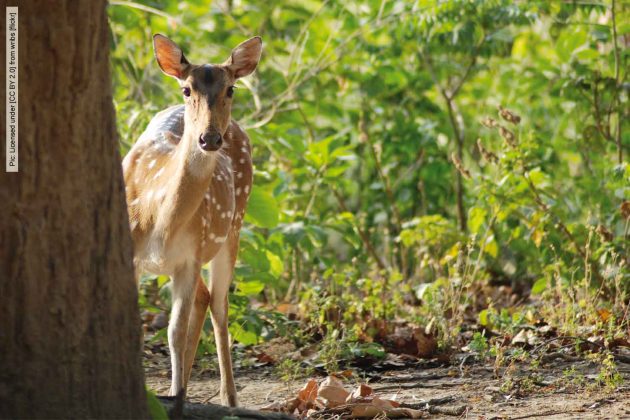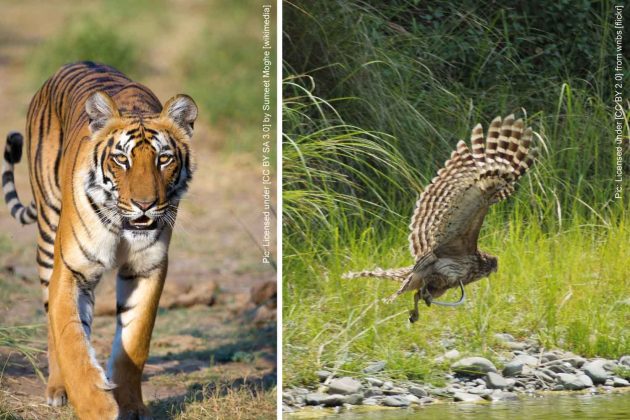It’s 5.30am as we bounce on the back of an open jeep on our way to the Jim Corbett National park. We’re irritable. Not just because we’re up before dawn to see a wild cat who we were sure would not extend the same courtesy to us, but also because at every bump on the road we are forced to hold on to the ice-cold bars of the jeep. I fear that my hands will freeze in place and wonder what will happen to my holiday then.
There is a theory that hospitality, particularly around wilderness, is much warmer to make up for the callousness of nature. At the Mahindra Club property on the fringes of the Jim Corbett National Park, we are cosseted like favoured grandchildren who are on their annual holidays. Outside, India’s first forest reserve does not grant us such considerations. On one side of the Kosi river is a low forest of wild kadipatta, lantana camara bushes, elephant grass, and teak wood, which we explore while sitting atop the 35-year-old Phoolmala—an elephant. It is late afternoon and Phoolmala gently sways through the forest. It’s not the best job for an elephant who would otherwise live in a matriarchal herd. On a regular day, she walks 15 to 18 hours; but it’s as good as it gets for an elephant in captivity. She gets to roam the forest, albeit under supervision. You can see that her favourite part is crossing the river.
In the thick of it
The water is clear enough to see the stripped pebbles on the river bed. Phoolmala and Rani, another elephant, stop to spray water on each other while passing and later make another halt to chomp the red berries in a bush. In the shade of low trees, we spot sambhal deers sitting—trying to escape the heat of the mid-morning sun. Peacocks also strut low, in no mood to show off their plumage to us.
It’s the same thing on the morning safari as jeeps line up to spot a tiger. Nature does not put up a display on call. The animal world does as it pleases—after all, it is we who are here to see and experience it and not the other way around. We chase monkey calls for a good two hours in a rope of open jeeps snaking around the forest. These tree dwellers are the first indicators that the cat is in the area—first a twittering to warn of the predator’s approach and then a deathly silence so it doesn’t know you are here. In the security of the big cat’s absence, herds of spotted deer brunch leisurely. An experienced one, clearly a millennial judging from its comfort level with the camera, turns and holds its good side for us. Termite hills provide landmarks. They are large enough to give credence to myth about rishis who meditate so long and deep that termites and ants build homes around them.
Still waiting
But the tiger remains elusive. There’s still dew on the grass and mist in the air. “He won’t come to the grassland until it is warm,” says our guide Subham Ratnagar. “Tigers don’t like the dampness of the dew.” He should know. His name is up on the board at the camp office to commemorate the latest tiger sighting. He’s from a nearby village Rampur and, like him, nearly everyone else in the surrounding towns make their livelihoods in Corbett. It’s a smart move to curb poaching. Anyone harbouring the intention to hunt big game would need a villager’s assistance.
Ratnakar has taken us around the circuit thrice. It’s about time we get out. The national reserve is open for sighting in two batches—dawn and dusk. There has been no sighting in our batch. The mood is one of disappointment, slowly giving away to a tendency to humour our situation. Jeeps pass each other with a monosyllabic exchange of “Dikha [Spotted]?” One mischievous retiree says enthusiastically, “Hahn! Uss ped ke neeche” [Yes! Under that tree].
Spotted at last
On our insistence, Subham takes us in for another circuit. Disappointment hangs like mist over the bunch in our jeep. No one expects to see a tiger so late in the day and we’re already talking, half-heartedly, about coming for the evening safari. “Tiger!” one of us cries and even as our mind is telling us he’s kidding, we see the tip of a tail swish on the road in front of us as a tigress leaps from the road into a hillock on the side of the road.
Ratnagar quickly takes us to the adjoining plane, and there she descends to walk through the dry grass. Her belly hanging low hinting to suckling cubs. She knows we’re around, but we aren’t interesting. She looks, she sniffs the air and dwindles along lazily, not yet imposed upon our presence. But there is a hint that we better not overstay our welcome; or get too curious. She won’t go near her babies while we are around; she won’t risk leading us too them. We turn around after following her for five minutes when she disappears into a thicket.
Analysed and discussed
I want to say it was majestic, even a life changing experience but it wasn’t. Something is diluted when you are a group catalyst to an experience and not a lone, silent, unspotted observer. There are too many discussions and debates later—everyone relates their version of how they spotted her. The story is broken down to too many details with too much retelling. Everyone practises aloud their version of spotting her. Credit is annexed for the creating the circumstances that led to the spotting—“I was the lucky mascot’; “I had a feeling we should turn around”; “We don’t like disappointing patrons, so when you said we should turn around I agreed even though it was after the prescribed tour.”
The tigress went on with her life, but we figuratively hoisted her like a trophy in our minds. We didn’t observe her quietly or think about what she thought of us. We didn’t wonder where she was going or what her plan for the day would be. Was she in the savannah for a hunt or a snooze? Where would the cubs be? What is her daily radius? A tiger we had come to see and we crossed that off our list.
Life in the hamlets
In between the warm embrace of professional hospitality and the callousness of the forest, lives the real life of the villages of the Pahad. Electricity lines run from Rampur, the nearest town, to the hotels and resorts that line the forest reserve, completely bypassing villages that have been rehabilitated along the stretch from areas prone to natural calamities. Some of these, like the hamlet Ringora, a village of 35 families, has been standing here for 40 years. Unrecognised as an official village by the government, the villages cannot have pukka [permanent] houses, electricity or running water. Corporates help them build schools and run home-businesses such as honey collection and knitting wares. Some of them are developing homestays for sustanence, besides providing tours of their fields and homes to showcase village life. The village is protected by an electrified gate that keeps out predators, an important move because the lantana bushes on the outskirts of the village are great hiding places for big cats. The roots of the bush keep the land dry and big cats don’t like to get their feet wet. Deep Malkani, a resident of the village and a guide, explains all this to us.
The land behind the village slopes up into a cliff that overlooks the Kosi river. A [reportedly] 315-year-old temple sits nestled in a 300-year-old banyan tree here. Youth such as Malkani conduct low-intensity zip-lining between the trees behind his village. There’s more such low-impact adventure if you go looking for it at the Jhula bridge over the Kosi river. You can rappel or slither down it to the clear water below.
None of us had the inclination to try any of these because we visited in November. Not for us the cold embrace of a freezing river or the bruises of a rappel line when we could be in our warm beds, practising retelling our story of how we saw a tigress.
How to get to Jim Corbett National Park
Ramnagar is the nearest station to the national park. Regular trains ply from Delhi every day. The Ranikhet Express leaves Delhi at 10.45pm and reaches Ramnagar at 5.30am. From Ramnagar, you can take a taxi to your hotel
Car: You can rent a taxi from Delhi for about INR 8000 one-way.
Bus: Buses ply from Anand Vihar and Maharana Pratap Interstate Bus Terminus in Delhi every half hour from 4pm to 9.30pm every day. They take about 8 hours to reach Ramnagar.
This was first published in the June 2015 issue of Complete Wellbeing.





